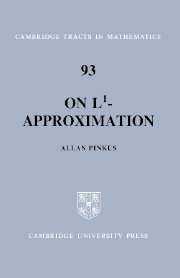Book contents
- Frontmatter
- Contents
- Preface
- 1 Preliminaries
- 2 Approximation from Finite-Dimensional Subspaces of L1
- 3 Approximation from Finite-Dimensional Subspaces in C1(K, μ)
- 4 Unicity Subspaces and Property A
- 5 One-Sided L1-Approximation
- 6 Discrete l1m-Approximation
- 7 Algorithms
- Appendix A T- and WT-Systems
- Appendix B Convexity Cones and L1-Approximation
- References
- Author Index
- Subject Index
Appendix A - T- and WT-Systems
Published online by Cambridge University Press: 06 January 2010
- Frontmatter
- Contents
- Preface
- 1 Preliminaries
- 2 Approximation from Finite-Dimensional Subspaces of L1
- 3 Approximation from Finite-Dimensional Subspaces in C1(K, μ)
- 4 Unicity Subspaces and Property A
- 5 One-Sided L1-Approximation
- 6 Discrete l1m-Approximation
- 7 Algorithms
- Appendix A T- and WT-Systems
- Appendix B Convexity Cones and L1-Approximation
- References
- Author Index
- Subject Index
Summary
As the title indicates, this appendix contains a collection of facts on T- and WT-systems. It is not our intention to provide a comprehensive treatise on this topic. A more all-inclusive study of T- and WT-systems may be found in Karlin, Studden [1966], Krein, Nudel'man [1977], and Zielke [1979]. Our purpose is to compile, in a cohesive fashion, some of the results used in the previous chapters. Part I contains a few facts concerning T-systems. In Part II we consider WT-systems. In the problem of L1-approximation, WT-systems play a more fundamental role that T-systems (see Chapter IV). As such, the emphasis of this appendix is more on the subject of WT-systems. Appendix B also contains a great deal of material on T- and WT-systems.
Part I. T-Systems
Chebyshev systems (the name was given by Bernstein [1926]) are abbreviated T-systems since at one time the Cyrillic transliteration gave us the spelling Tchebycheff (and variants thereof). They are fundamental in the study of approximation theory. At times T-systems and T-spaces are referred to as Haar systems and Haar spaces, respectively. Formally a system in this context is meant to be a finite sequence of functions, and a space is their linear span. None the less, we shall use the term system for both the system and the space. We will however differentiate between T-systems and Haar systems.
Definition 1. Let B be a compact Hausdorff space and C(B) the set of realvalued continuous functions on B.
- Type
- Chapter
- Information
- On L1-Approximation , pp. 194 - 206Publisher: Cambridge University PressPrint publication year: 1989



